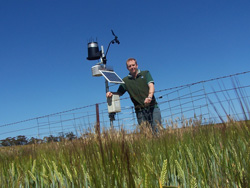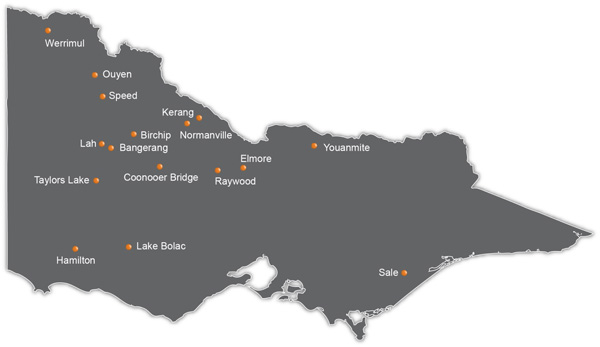Monitoring soil moisture in dryland cropping areas
The 'Risk Management through Soil Moisture Monitoring Project (SMM)' started in 2011 to provide dryland grain growers with useful information to assist with their decisions around sowing and crop selection. Positive feedback from the 2013 and 2014 SMM survey reports lead to the extension of funding for the monitoring component of this program through the Grains Seasonal Risk Program with the Rain, Grain and Food to Asia projects.

This project, conducted by Agriculture Victoria will assist the grain sector to maintain production with large variation in seasonal conditions. Increasing targeted inputs and improving crop management will be accomplished by helping industry to understand soil and water interactions and critical crop growth stages, as well as factoring in forecasted seasonal predictions.
Crop potential and cropping inputs are increasingly subject to greater instability and uncertainty due to seasonal variability. Grain growers are under pressure to increase production across a range of seasons, and adding to the complexity is the fact that under climate change, annual rainfall is projected to decrease and its seasonal distribution is expected to change.
Monitoring water availability, without the use of SMM probes, makes the process of estimating appropriate inputs and other management decisions difficult. Until recently, the practice of using soil moisture probes has had limited use in the dryland cropping industry and few farmers have had access to this technology.
We are providing live, deep soil moisture data to help dryland croppers, farmers, and advisors/managers validate the SMM technology, as well as conducting training to interpret the data for crop decision making. Results are communicated in regular editions of the 'Soil Moisture Monitoring' and 'The Fast Break' newsletters, 'The Very Fast Break' video, and through farm field days and meetings. A link to live data can be accessed via the SMM newsletter.
Sites and measurements

- Northern Irrigation — Kerang
- South Gippsland — Sale
- Northern East — Youanmite
- Central — Raywood, Coonooer Bridge, Elmore
- South West — Hamilton, Lake Bolac, Yalla-Y-Poora
- Wimmera — Brim (Lah) Taylors Lake and Bangerang (Sheep Hills)
- Mallee — at Speed, Werrimull, Birchip, Ouyen and Normanville
These sites are being monitored using 'capacitance probes' that take hourly measurements of soil water content through the soil profile.
Sensors on the capacitance probes measure zones every 10cm, from a depth of 30cm down to 1m. A total of 8 measurements from 8 probes are taken at each site, with the data collected sent via the mobile phone network to a server which stores the data to allow interpretation through graphing software.
Benefits of the SMM program
Soil moisture probes record absolute soil water content. With over 6 years of monitoring, the probes have built up knowledge of upper and lower moisture limits for crops under different soil and crop types for many of the sites. Measuring soil moisture will also help provide an indication of:
- yield potential based on plant available water
- crop water use
- sub soil moisture base and reserves
- rainfall required to refill soil profile
- water infiltration
- water logging
- water use of different crops and the water remaining in the profile after crops are cut for hay
Access to this data enables growers and advisors to:
- measure moisture at points in paddocks representative of the farm
- use live soil moisture data from a representative site for a particular rainfall region and soil type
- monitor localised weather (rain, wind and temperature/humidity) as well as down load historical data from an archive list for farm management records
- increase production and efficiencies
- help farmers to adapt to seasonal variability and climate change
- make informed input decisions such as minimising input in low soil moisture years base and maximising yield potential in more favourable conditions based on current soil moisture levels and incorporating seasonal forecasts probabilities
- determine if measurements obtained through the life of the project could be relevant at whole farm or even district level
- enable crop forecasting models to incorporate the live soil moisture data that is collected from a representative soil in a particular rainfall region, therefore providing more accurate advice and increasing production and dollars for growers.

Where you can access the data
View soil moisture data on extensionAUS.
About extensionAUS™
extensionAUS™ is an online information hub for Australian rural industries that brings together scientists, academics and practitioners to collaborate, share knowledge and research, create ideas and solutions. Based on the concept 'together we can achieve more', the platform connects agricultural professionals to support practice change on-farm. Learn more about extensionAUS.
Risk assessment
Below are some examples of options you may choose for your paddocks depending on the soil moisture results obtained. Being able to accurately measure soil moisture when required provides opportunities to aid management decisions at various stages in the production cycle. As more information is collected over a wider range of seasons, confidence levels will increase as comparisons can be made between years.
| Production stage | Moisture level | Management action |
|---|---|---|
| Sowing | High | Early sow long season varieties, canopy management to maximise yields. |
| Sowing | Middle | Reduce upfront input costs, seed rate, fertiliser, and herbicides. Canopy management for average yields. |
| Sowing | Low | Reduce upfront costs, and seed rate. Consider decreasing area sown, target lower risk crops and more productive paddocks. |
| Early/late tillering | High | High confidence in nitrogen application, weed and disease management. |
| Early/late tillering | Middle | Lower confidence level. Reduce rates of N application. |
| Early/late tillering | Low | Low confidence level. Reduce costs, consider grazing or hay later in the season. |
| Stem elongation | High | High confidence. Apply late N, fungicides and pesticides. |
| Stem elongation | Middle | Lower confidence. Reduce rates of N. |
| Stem elongation | Low | Low confidence. No N. No forward selling. Consider grazing and hay production |
| Flowering | High | High confidence. Consider forward selling options if favourable. Head counts to determine potential yield. |
| Flowering | Middle | Lower confidence. Reduce forward selling quantities. Head counts to determine potential yield. |
| Flowering | Low | Low confidence. No N. No forward selling, consider grazing and hay production. |
| Pre harvest | High/middle/low | Determine potential yields. Adjust insurance estimates. |